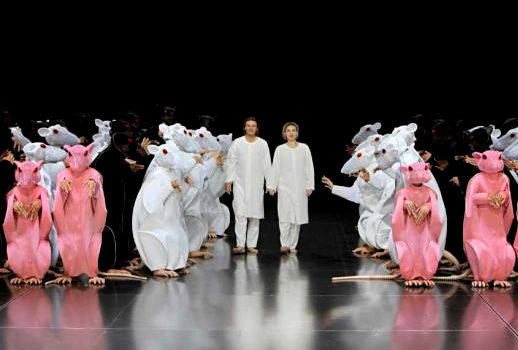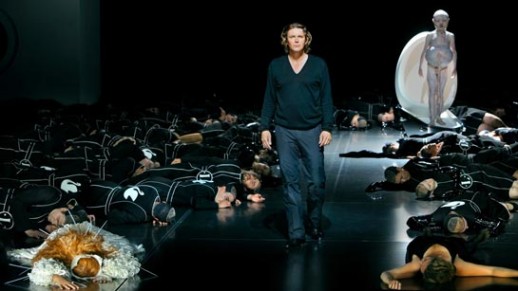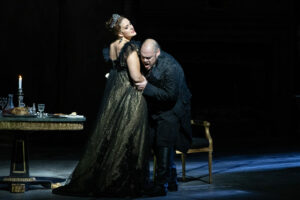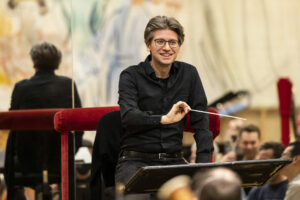

For example, in Art and Revolution, Wagner attacks Christianity for promising “unmerited mercy from God” and thereby rationalizing “a dishonorable, futile, and wretched existence for humanity on earth.” Wagner takes a dismissive attitude towards the church because he believed it did not support the practice of Christianity as Jesus intended (and who better than Wagner to understand Jesus’ intentions?) Neuenfels’ Lohengrin uses this idea to explore how the society’s institutions have deprived mankind of their humanity and how that hoping for salvation rather than taking action is a very dangerous strategy.
Accordingly, Brabant is an institution, but of the medical kind, as sleek and gleaming white as an Apple store. Most of the subjugated human occupants have recently shaved heads, suggesting brain surgery. They have apparently been conditioned to believe that they are rats; however, they are just wearing rat-suits, complete with glowing red eyes. At festive, celebratory moments chosen by their overlords, they are allowed to remove their rat suits and display their human clothes and features underneath. Rows of numbered clothing hooks, which match the correspondingly numbered rat suits, descend from the sky and then lift back up, leaving the rat suits dangling overhead as if we are in some horrific rodent abattoir.
Brabant is also a prison; the citizens are locked in and kept under strict control by figures in Blue-Hazmat suits and the Herald, who sports a Don King hairdo and treats the king as his puppet. Is the Herald the Dr. Moreau figure running the place? He is the most senior person we saw, but I did not believe he was in charge. Only Elsa, Ortrud, Telramund, and Lohengrin have no telltale signs of baldness; perhaps, their full human nature needs to be intact for them to play out the morality play that follows.
During the prelude, Lohengrin tries force his way into Brabant to find a sweet German girl who will love him unconditionally. Eventually, he is admitted. He disappears and the “people” of Brabant assemble, clutching their spindly hands in glee at the prospect of a trial. The oak tree is a sickly potted plant and there is no river.
When Elsa enters, she is dressed in a white coat pierced with arrows, suggesting her eventual martyrdom in the name of teaching the populace an important lesson. During Telramund’s indictment of Elsa, an accusatory video is played that depicts all the parties in the case as rats. As Lohengrin nears, the rats change into hideous yellow festive suits. Lohengrin walks in followed by four rats carrying a tub with a fake swan in it.
In a particularly telling touch during the fight with Telramund, a second video is shown depicting Ortrud as the true culprit. Telramund’s shock allows Lohengrin to easily gain advantage. As the populace celebrates Lohengrin’s victory, they do a choreographed jubilation routine, which ends abruptly when the fake swan plops down from the sky suspended on a wire, causing the populace to cower in fear.
Act II begins with Ortrud and Telramund immobile under drop cloths amidst a wrecked carriage and a dead horse. Rats scavenge their possessions. They awaken when their coverings are removed. Have their Masters duped them into thinking they tried to escape? Ortrud, now in a man’s outfit, is extremely sexual in her manipulation of Telramund.
Since there are no chairs in sight, there’s lots of writhing on the obsessively clean floor (Can we officially declare a moratorium on treating singers as Swiffers?) Elsa’s balcony is a glass cube with a plastic swan; the poor swan gets severely manhandled by Ortrud. Elsa is starting to show signs of mental instability and Ortrud destabilizes her even more.
During the interlude between scenes, some rats get the upper hand attacking the haz-mat crew. However, their victory is brief; the male rats are in their cages at the start of the cathedral scene. At the very end of Act II, when Elsa, now dressed as a swan, and Lohengrin are about to enter the cathedral, the Blue Man Group return a to yank away the cross from in front of the church since it has served its purpose. It pulls apart into two pieces, but Lohengrin grabs them and holds the reassembled cross aloft over the crowd with a defiant look, neatly illustrating the difference between the practice of religion and true faith. The citizens begin to pray while Elsa flutters her arms slowly like a swan.
In Act III, the marriage bed is roped off like a museum exhibit and surrounded by a semicircle of chairs, unused by whatever observers they were intended for. When Lohengrin summons the populace, they are in stylized chivalric outfits that all have L’s on them, even though Lohengrin’s name is still unknown. Did the uber-Brabantians think they knew how this would all play out? Did Elsa’s human nature force her to go off script?
At the opera’s close, Lohengrin’s tub/boat returns with a large object under a cloth. He reveals it is a large egg, which slowly revolves, revealing “Gottfried” to be a hideous child- sized male fetus. If Lohengrin intended to use his year with Elsa to produce a true hero who could free the people, ending his science project early has only produced a monster. Everyone save Lohengrin collapses dead, shocked by the realization that salvation is a fraud. Lohengrin walks slowly to the front of the stage in mute horror realizing the consequences of assuming he could find someone with true faith, not just a set of learned behaviors.
This thoughtful view of the work was riveting to watch unfold. Every detail in the staging had a purpose and he elicited fantastically nuanced acting performances from his Lohengrin and Elsa. His work is deliberately provocative, determined to jolt the audience out of any pre-conceived notions of what a work is about. This time, his provocations were more disciplined than they have been and there was little of the perverse, anarchic humor that has overwhelmed his previous stagings such as the notorious Die Fledermaus for Salzburg.
Ultimately, however, it was not completely satisfying. It reminded me of the finale of the TV show Lost where all the intimations of agency and Grand Design remained largely unexplained when the show ended. I recognize that any big reveal of the Wizard of Brabant would prove anticlimactic, but was this Brabant some strange experimental place or is it the world we know? As with the Tannhäuser the night before, setting an opera in a highly artificial environment distances the audience from the feelings and emotions, thus lessening the impact of the work.
The performance featured the one genuine star turn of the festival, Klaus Florian Vogt’s Lohengrin. He has a voice of extraordinary purity that projects and fills the house with ease, without any apparent strain or effort. Even if Bayreuth is a singer’s house, no other voice heard I’ve heard there sounded as burnished as his did. He received an extended ovation and was besieged by fans when he attended Parsifal the next day.
Andris Nelsons provided the best conducting of the week. Only he demonstrated full mastery of the Bayreuth acoustic, allowing the strings to shimmer, letting the brass have the proper weight and properly balancing voices with orchestra. Climaxes were built with impressive care. Tempi were urgent, but never rushed except perhaps in Elsa’s opening aria, but Annette Dasch couldn’t sing it properly anyway.
She was the biggest disappointment of the night. Every extended note was squeezed out and their was no purity or particular beauty to her timbre. Turning was off in many critical moments Her acting, while very admirable, did not compensate for a seeming lack of basic singing technique.
Petra Lang was a ferocious Ortrud, but she could not soften her tone or style for the character’s more insinuating moments. It grew wearisome over the course of an entire performance. Jukka Rasilainen’s Telramund couldn’t really compete with her; his voice had little impact and made his character seem more of a loser than he should be.
Samuel Youn made a fine impression as the Herald, but I would have to hear him in something else to determine his capacity for nuance. Georg Zeppenfeld was appropriately stentorian as the King. I’d like to hear him again in a different part. Once again, the chorus gave a best-in-class performances. The staging kept them very busy, but their sound and concentration never wavered, as singers or actors.
Photos: Enrico Nawrath / Bayreuther Festspiele.


























Comments